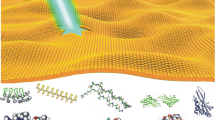Abstract
Controlling the arrangement and organization of self-assembled peptide nanostructures is a crucial step in developing Lab-on-a-Chip devices based on biomolecular assembly. Here, we report a simple approach to achieve the vertically aligned assembly of diphenylalanine (FF) peptide by casting stock solution of FF peptide on gold and graphite modified silicones. We show at the first time the formation of highly ordered interlaced arrays of vertical flower crystals and peptide nanotubes (PNTs) on thiolated gold and graphite. Furthermore, their chemical stability was investigated in PBS buffer after 3 h to gain insight into the stability of modified electrodes upon cycling. Interestingly, a highly ordered hierarchical morphology was obtained on the substrate surface. Hierarchical morphology resembles a square lattice, dendritic forest, and three-dimensional packed arrays. The results confirmed that PNTs not only preserves its chemical stability but transform into hierarchical arrays in PBS which is very beneficial for their applications in bioelectrochemical and nanoelectronics devices. As an example, the significantly enhanced arrangement of antibody CD3 was also demonstrated at the PNTs modified gold electrode compared to unordered modified electrodes. The simple and mild approach described here opens a new path for the fabrication of organized self-assembled peptide bionanostructure arrays allowing the fabrication of a variety of microarrays used in practical applications.








Similar content being viewed by others
References
T. Fatanat Didar, A.M. Foudeh, M. Tabrizian, Patterning multiplex protein microarrays in a single microfluidic channel. Anal. Chem. 84, 1012–1018 (2012)
E. Tayerani Nicknejad, S.M. Ghoreishi, N. Habibi, Electrospinning of cross-linked magnetic chitosan nanofibers for protein release. AAPS PharmSciTech 16(6), 1480–1486 (2015)
J.D. Hatgerink, E. Beniash, S.I. Stupp, Self-assembly and mineralization of peptide-amphiphile nanofibers. Science 294, 1684–1688 (2001)
N Habibi, N. Kamaly, A. Memic, H. Shafiee, Self-assembled peptide-based nanostructures: smart nanomaterials toward targeted drug delivery. Nano Today, 11(1), 41–60 (2016)
N. Habibi, Immobilization of bacterial S-layer proteins from Caulobacter crescentus on iron oxide-based nanocomposite: synthesis and spectroscopic characterization of zincite-coated Fe2O3 nanoparticles. Spectro Acta A 125, 359–362 (2014)
X. Yan, P. Zhua, J. Li, Self-assembly and application of diphenylalanine-based nanostructures. Chem. Soc. Rev. 39, 1877–1890 (2010)
T. Zohrabi, N. Habibi, Dendritic peptide nanostructures formed from self-assembly of di-L-phenylalanine extracted from Alzheimer’s β-amyloid poly peptides: insights into their assembly process. Int. J. Peptide Res. Ther. 21, 423–431 (2015)
M. Reches, E. Gazit, Casting metal nanowires within discrete self-assembled peptide nanotubes. Science 300, 625–627 (2003)
J. Ryu, S.Y. Lim, C.B. Park, Photoluminescent peptide nanotubes. Adv. Mater. 21, 1577–1581 (2009)
C.A.E. Hauser, S. Zhang, Peptides as biological semiconductors. Nature 468, 516–517 (2010)
N. Kol, L. Adler-Abramovich, D. Barlam, R.Z. Shneck, E. Gazit, I. Rousso, Self-assembled peptide nanotubes are uniquely rigid bioinspired supramolecular structures. Nano Lett. 5, 1343–1346 (2005)
L. Adler-Abramovich, M. Reches, V.L. Sedman, S. Allen, S.J.B. Tendler, E. Gazit, Thermal and chemical stability of diphenylalanine peptide nanotubes: implications for nanotechnological applications. Langmuir 22, 1313–1320 (2006)
J. Ryu, S.-W. Kim, K. Kang, C.B. Park, Mineralization of self-assembled peptide nanofibers for rechargeable lithium ion batteries. Adv. Mater. 22, 5537–5541 (2010)
B.-W. Park, R. Zheng, K.-A. Ko, B.D. Cameron, D.-Y. Yoon, D.-S.A. Kim, Novel glucose biosensor using bi-enzyme incorporated with peptide nanotubes. Biosens. Bioelectron. 38, 295–301 (2012)
M. Reches, E. Gazit, Controlled patterning of aligned self-assembled peptide nanotubes. Nat. Nanotechnol. 1, 195–200 (2006)
J. Ryu, C.B. Park, High-temperature self-assembly of peptides into vertically well-aligned nanowires by aniline vapor. Adv. Mater. 20, 3754–3758 (2008)
L. Adler-Abramovich, D. Aronov, P. Beker, M. Yevnin, S. Stempler, L. Buzhansky, G. Rosenman, E. Gazit, Self-assembled arrays of peptide nanotubes by vapour deposition. Nat. Nanotechnol. 4, 849–854 (2009)
P. Li, X. Chen, W. Yang, Graphene-induced self-assembly of peptides into macroscopic-scale organized nanowire arrays for electrochemical NADH sensing. Langmuir 29, 8629–8635 (2013)
N. Habibi, Functional biocompatible magnetite–cellulose nanocomposite fibrous networks: characterization by fourier transformed infrared spectroscopy, X-ray powder diffraction and field emission scanning electron microscopy analysis. Spectrochim. Acta Part A Mol. Biomol. Spectrosc. 136, 1450–1453 (2015)
N. Habibi, B. Karimi, Fabrication and characterization of zinc oxide nanoparticle coated magnetic iron oxide: Effect of S-layers adsorption on surface of oxide. J. Ind. Eng. Chem. 20(5), 3033–3036 (2014)
N. Habibi, Preparation of biocompatible magnetite-carboxymethyl cellulose nanocomposite: characterization of nanocomposite by FTIR, XRD, FESEM and TEM. Spectrochim. Acta Part A Mol. Biomol. Spectrosc. 131, 55–58 (2014)
T. Zohrabi, N. Habibi, A. Zarrabi, M. Fanaei, L.Y. Lee, Diphenylalanine peptide nanotubes self-assembled on functionalized metal surfaces for potential application in drug-eluting stent. J. Biomed. Mater. Res. Part A 104(9), 2280–2290 (2016)
P. Kumaraswamy, R. Lakshmanan, S. Sethuraman, U.M. Krishnan, Self-assembly of peptides: influence of substrate, pH and medium on the formation of supramolecular assemblies. R. Soc. Chem. doi:10.1039/c0sm00897d
N. Habibi, F.C. Soumetz, M. Guillaneli, L. Pastorino, O. Herrera, F. Subrana, R. Raiteri, C. Ruggeiro, Self-assembly and recrystallization of bacterial S-layer proteins of Bacillus sphaericus and Bacillus thuringiensis on silicone, mica and quartz crystal supports. Eng. Med. Biol. Soc. (EMBC) 2010, 3139–3742 (2010)
L. Soleymani, Z. Fang, X. Sun, H. Yang, B.J. Taft, E.H. Sargent, Nanostructuring of patterned microelectrodes to enhance the sensitivity of electrochemical nucleic acids detection. Angew. Chem. Int. Ed. 48, 1–5 (2009)
T.H. Han, J.K. Oh, G.-J. Lee, S.-I. Pyun, S.O. Kim, Hierarchical assembly of diphenylalanine into dendritic nanoarchitectures. Colloids Surf. B 79, 440–445 (2010)
V.V. Korolkov, S. Allen, C.J. Roberts, Surface mediated L-phenylalanyl-Lphenylalanine assembly into large dendritic. Faraday Discuss 166, 257–266 (2013)
E. Chan Choa, J.-W. Choi, M. Lee, K.-K. Koo, Fabrication of an electrochemical immunosensor with self-assembled peptide nanotubes. Colloids Surf. A Physicochem. Eng. Aspects 313–314, 95–99 (2008)
Author information
Authors and Affiliations
Corresponding author
Rights and permissions
About this article
Cite this article
Moini, E., Dadkhah, A.A., Allafchian, A. et al. Patterning protein conjugates into organized microarrays with diphenylalanine peptide nanotubes self-assembled on graphite and gold electrode. J Mater Sci: Mater Electron 28, 16910–16920 (2017). https://doi.org/10.1007/s10854-017-7610-2
Received:
Accepted:
Published:
Issue Date:
DOI: https://doi.org/10.1007/s10854-017-7610-2




